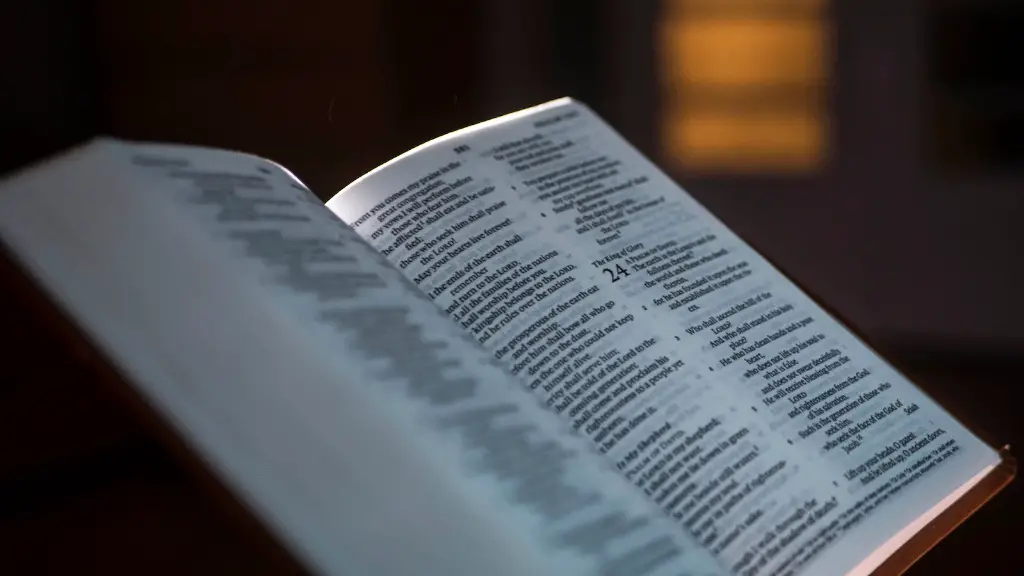Overview of Cain and Abel
Cain and Abel are two important figures in the Bible; referred to in the book of Genesis and throughout the Old Testament. Able was the firstborn son of Adam and Eve, and Cain was born shortly thereafter. The story of Cain and Abel, and their relationship as brothers, are well known to Christians, Jews, and Muslims alike. According to the Bible, Cain and Abel each offered God a sacrifice; however, God accepted Abel’s offering and rejected Cain’s. Out of envy, Cain killed his brother Abel, an act which God punished him for by banishing him east of Eden. While the story of Cain and Abel is important in Christian and Jewish scriptures, their legacy goes beyond the Bible and their symbolic power resonates in many cultures.
Biblical Impact
The narrative of Cain and Abel appears early on in the Bible, thus serving as a foundational story for the rest of the Bible. Their relationship illustrates the concept of brotherly love and the pitfalls of jealousy, as well as sets a precedent for the idea of sin, punishment, and redemption. Throughout their narrative, their relationship is described as that of envy rather than one of love and respect. The ultimate cost of their enmity is Abel’s death, a stark reminder of the power of envy. The story implies that the consequences of such behavior are death, perversion and alienation.
The story is not only an example of fratricide but demonstrates God’s justice and mercy, as per the Bible. God punished Cain for his sin, but according to a talmudic development of the story, God only banished Cain as he believed that death would be too harsh a sentence for him.
Symbolic Interpretations
Cain and Abel have been interpreted variously by different cultures and religions. In some cultures Cain was the symbol of temptation and wickedness, while Abel was the symbol of innocence and goodness. In most cases, Abel was seen as a positive example to be emulated while Cain embodied a negative instruction not to be followed. In Christian iconography, Abel is usually represented as a shepherd, surrounding him with the symbolism of innocence and purity.
The story of Cain and Abel and its symbolic meaning is important in literature and art. From the Renaissance onward, religious painting and artwork often depicted the story of Cain and Abel, in order to emphasize the consequences of envy and selfishness. Additionally, the story of Cain and Abel serves as a cautionary tale in relation to personal and communal justice and order, with King James calling it a ‘formidable example of the prevalence of envy and of revenge’.
Cain and Abel’s Legacy
Given the story of Cain and Abel’s prominent place in the Bible, it has been adopted and adapted by societies and cultures throughout time. Fyodor Dostoyevsky’s novel The Brothers Karamazov, for instance alludes to the story, with the ongoing battle between two brothers and their father’s preference for one over the other. In a slightly different interpretation, the film The Good, The Bad, and The Ugly employs the relationship between Tuco, Angel Eyes and Blondie, which some viewers liken to the biblical story. In the novel Brave New World, Cain and Abel are mentioned in the in the context of a ‘Cain-complex’, which describes a feeling of envy towards others that has deep roots in literature and psychoanalysis.
Cain and Abel in Pop Culture
The story of Cain and Abel is often referenced in popular culture, particularly music. Bob Dylan’s ‘The Ballad of Hollis Brown’, and the Kinks’ ‘Catch Me Now I’m Falling’ both allude to the story. U2’s’Angel of Harlem’, references the brothers through imagery- ‘Cain, he wrapped his brother Abel, in a force so tender, steely and frail’. Additionally, the story’s influence can virtually be heard in contemporary rap music, with references to Abel and Cain being included in lyrics.
Cain and Abel have also featured as characters in numerous works of fiction and movies. In The Book of Genesis, for example, Adam and Eve’s sons are featured prominently, and their relationship and ultimate demise are included. In the movie I Spit on your Grave, the main antagonist is named ‘Cain’, after the biblical Cain, and is portrayed as a violent man. Conversely, Abel is frequently portrayed as meek and mild-mannered, often attempting to protect the violent Cain from his own aggression.
Cain and Abel in the Modern Context
In the modern context, the archetypal theme of rivalry between brothers is readily apparent in Cain and Abel’s narrative. To this day, Cain and Abel remain a powerful symbol of fraternal rivalry—of how envy and jealousy can lead to severe consequences if unchecked.
In addition to illustrating the danger of envy, the story of Cain and Abel also serves as reminder of how complex, and ultimately uncertain, human relationships can be. The impact of Cain and Abel’s relationship has been felt in various communities throughout the world, and continues to be interpreted in a contemporary context.
The themes of the Cain and Abel story are strongly evident in men’s lives. Men often compare themselves to their brothers and fathers, and experience envy or jealousy as a result. Medical professionals have linked the ‘Cain complex’ to an elevated risk for male depression and post-traumatic stress. The moral lesson to be taken away from the story of Cain and Abel is the reminder that envy is never justified or acceptable, and can have grave consequences.
Impact of Literature
The story of Cain and Abel has been especially impactful on literature and the arts. Novels, films, and music alike have often incorporated the story of Cain and Abel as part of the script. For example, the novel The Great Gatsby portrays the rivalry between Jay Gatsby and Tom Buchanan as similar to the rivalry between Cain and Abel. Similarly, in Thomas Mann’s novel The Magic Mountain, the relationship between two siblings, Hans and Adolf Castorp, is drawn in stark contrast to the Cain and Abel’s story to demonstrate their own power dynamics.
Cain and Abel’s influence can also be seen in films, with one of the more notable films being John Frankenheimer’s 1962 adaptation of Richard Condon’s novel The Manchurian Candidate. Here, the film took the Cain and Abel motif to demonstrate the characters’ power struggles, using the stories of fraternity, sacrifice and betrayal.
Impact on Music
The story of Cain and Abel has found its way into music for centuries. Due to its prominent place in the Bible, the story has held symbolic power for many artists across the ages. For instance, Antonio Vivaldi composed a cantata based on Cain and Abel’s story. Similarly, John Milton’s poem ‘Lycidas’ was inspired by the story of Cain and Abel, and references other Bible passages about fratricide.
The influence of Cain and Abel is also visible in contemporary music. The Red Hot Chili Peppers song called, ‘Monarchy of Roses’ alludes to the story, with the lyrics ‘Spread the wings of the Eagle of War, and bind together the broken, who forged it’ referring to the brothers’ struggles. Similarly, the band ‘For King and Country’ wrote a song clearly inspired by the Cain and Abel narrative, titled ‘Proof of Your Love’.
Impact of Visual Arts
The influence of the Cain and Abel story in visual art is also evident. Botticelli’s early Renaissance masterpiece, ‘The Temptation of Christ’, brings out the nuances of the story. In the painting, Botticelli portrays the characters of Cain and Abel, as well as their actual struggle, by having an angel intervene in order to calm tensions between them.
Additionally, classical works in sculpture and pottery often depict the relationship between Cain and Abel, as well as the struggle between brothers. Many of these works were done in Roman times, highlighting the continued acknowledgement of the story and its influence.
Overall, Cain and Abel has been able to hold an important place in modern art and literature, and will likely continue to do so for generations to come.


